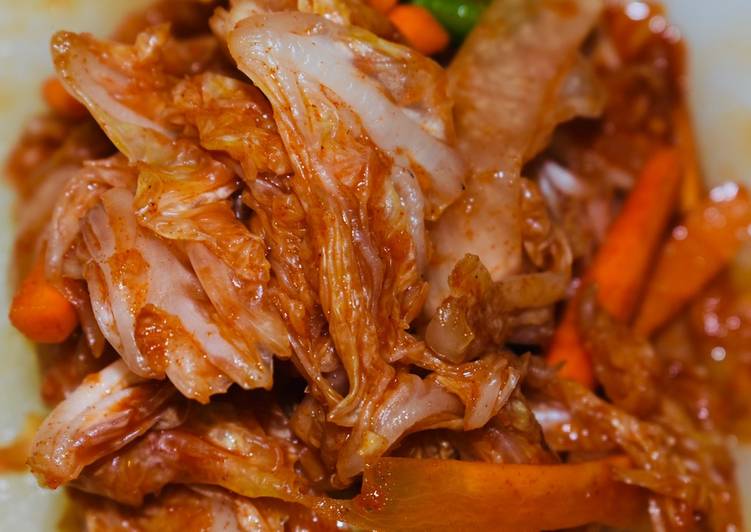Korean Kimchi. Repeat layering all of the cabbage has been salted. Kimchi (김치) is a collective term for vegetable dishes that have been salted, seasoned, and fermented. The history of kimchi goes back to ancient times.
 Kimchi is a fermented dish, the more it ages the better it tastes, likewise with the sugar. Use a persimmon in place of the apple, if you prefer. Combine paste, carrots, green onion, and cabbage until it's all well-coated. You can have Korean Kimchi using 8 ingredients and 9 steps. Here is how you achieve it.
Kimchi is a fermented dish, the more it ages the better it tastes, likewise with the sugar. Use a persimmon in place of the apple, if you prefer. Combine paste, carrots, green onion, and cabbage until it's all well-coated. You can have Korean Kimchi using 8 ingredients and 9 steps. Here is how you achieve it.
Ingredients of Korean Kimchi
- It's 2 inch of ginger.
- Prepare 6 cloves of garlic.
- Prepare 1/4 cup of fish sauce.
- It's 1/4 cup of Korean chilli flakes.
- Prepare 2 of carrots.
- You need 1/3 cup of green onions.
- Prepare 1 of daikon radish.
- Prepare 1 of napa cabbage.
Pack the kimchi into glass jars leaving room at the top. Fold the extra leaves and press them into the top to hold down the smaller leaves. This will save you from using fermentation weights. Directions Kimchi (김치) consists of cabbage that has been salted and fermented, over a number of days, in a spicy sauce made up from a large number of ingredients including chilli powder, spring onions, fish sauce and onion.
Korean Kimchi step by step
- So cut the cabbage in two and cut the half in half.
- Cut it into a few parts and put it into a large bowl and over season that cabbage with salt, make sure every one of the cabbage gets that salt,put it aside for 1 hour.
- I used only half a daikon radish, cut it julienne.
- Do the same for the carrots and chop some spring onions as well.
- After your cabbage is marinated in that salt there will actually be allot of water and the cabbage will shrink, rinse well if not it’ll be quite salty put in the rest of your vegetables with your cabbage (carrots, radish, green onion).
- Blend the garlic and ginger with the fish sauce and add the Korean chilli powder or flakes into the paste use less if you can’t take spicy or more if you love the kick.
- Mix well until you reach a paste.
- Put the paste into the vegetable and mix well, please use gloves if you can it can irritate sensitive hands so use gloves if you can, after mixing transfer it into a glass jar or container and store it in room temperature for 4-6 days depending on your taste DO NOT AIR TIGHT SEAL IT MAKE SURE THERES AIR, after it reaches to the liking of your taste store it in your fridge for up to 3 months.
- And there you go KIMCHI.
Kimchi is to a Korean as ketchup is to an American. You can eat a meal without it, but it tastes so much better with it. In fact, when I eat pizza or used to eat a hamburger, I sometimes craved kimchi along with them. The crisp, crunchy, spicy cabbage with a hint of sour taste, cleansed my palate after eating meat. The word "sinto" comes from an old Korean saying, "sinto buri," meaning that body and soul cannot be separated, and the rich family history behind this brand is just as soulful.
Comments
Post a Comment